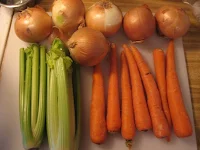Stock
To begin, let's take the simple definition. Most soups start with some type of broth or stock which is defined as; a liquid (usually water) that is fortified with a definite flavor. Different types of stocks include, vegetable, chicken, beef, duck, fish, lobster, corn, asparagus, etc The list is endless depending on what flavor you are looking for and, of course the ingredients that you are going to use it in. The final flavor you are trying to achieve determines how you are going to treat the ingredients going in. As an example were you to be making corn stock, your flavors would take on a completely different profile if you were using raw corn vs. roasted corn. Developing a base flavor is an important part, if not the most important part, of a successful soup and that can be achieved in many ways. If the home cook wants to make a meaty and rich soup for instance, it is important to caramelize the meat and vegetables first, then deglaze the pan with a liquid (sometimes red or white wine) to remove the flavorful pieces from the bottom of the pan (called fond) and add those flavors to the soup resulting in a richness of flavor that we discussed in my last installment, Umami. A French term called ‘Mirepoix,’ is the foundation of most soups and stocks. This is a mixture of 2 parts onion, 1 part carrot, and 1 part celery. Aromatics are flavor enhancers that are added to your stock to bloom or boost flavors. Aromatics include: peppercorns, bay leaves, juniper berries, any herbs, any onions, or garlic.
 Most importantly, we need to determine what type of stock we want to create, and then decide what the future of our beautiful stock will be. After you have added all your ingredients, you are now ready to let your stock simmer. A simmer is a temperature between 190-200 degrees and different stocks have different simmering times in order to reach their fullness of flavor:
Most importantly, we need to determine what type of stock we want to create, and then decide what the future of our beautiful stock will be. After you have added all your ingredients, you are now ready to let your stock simmer. A simmer is a temperature between 190-200 degrees and different stocks have different simmering times in order to reach their fullness of flavor:Vegetable stocks~45 minutes
Fish stocks~1 hour 30 minutes
Chicken (Poultry) stocks~2 hours
Beef stocks~6 hours ( pre-roast the bones)
Fish stocks~1 hour 30 minutes
Chicken (Poultry) stocks~2 hours
Beef stocks~6 hours ( pre-roast the bones)
 Once your stock is completely simmered to it's full richness, the final step is straining your it properly. What we are looking for is a pure, smooth and beautiful liquid so at this point we need to pass it through a strainer or "cheesecloth" to remove all impurities and vegetables, or large ingredients. Your stock can now be used immediately, or can be frozen in smaller batches to be thawed and used the next time you decide to make a soup or sauce.
Once your stock is completely simmered to it's full richness, the final step is straining your it properly. What we are looking for is a pure, smooth and beautiful liquid so at this point we need to pass it through a strainer or "cheesecloth" to remove all impurities and vegetables, or large ingredients. Your stock can now be used immediately, or can be frozen in smaller batches to be thawed and used the next time you decide to make a soup or sauce.Soup
Soup is a food that is made by combining ingredients such as meat and vegetables in stock or hot/boiling water, until the flavor is extracted, forming a broth. Traditionally, soups are classified into two broad groups: clear soups and thick soups. The established French classifications of clear soups are bouillon and consommé. Thick soups are classified depending upon the type of thickening agent used:purées are vegetable soups thickened with starch;
bisques are made from puréed shellfish thickened with cream;
cream soups are thickened with béchamel sauce;
veloutes are thickened with eggs, butter and cream.
Other ingredients commonly used to thicken soups and broths include rice, flour, and grains and beans. The word soup originates from "sop," a dish originally consisting of a soup or thick stew which was soaked up
 with pieces of bread. The modern meaning of sop has been limited to just the bread intended to be dipped.
with pieces of bread. The modern meaning of sop has been limited to just the bread intended to be dipped.Cooking with the seasons can be a lot of fun, s when thinking soups and stocks, consider ingredients available at that time of year and enjoy gathering ingredients that are at their peek of freshness. Autumn is by far my favorite season for soups and I enjoy making heartier soups. Below is a simple recipe for butternut squash soup. It should only take approximately 35 minutes to prepare and the flavors are wonderful!
Butternut Squash Soup
Ingredients
1 butternut squash, peeled1 onion, chopped
2 tsp nutmeg
2 tablespoons unsalted butter
6 cups chicken stock
Salt and pepper (to taste)
Method
Cut squash into 1-inch chunks. In a large pot melt butter. Add onion and cook until translucent, about 8 minutes. Add squash and stock. Bring to a simmer and cook until squash is tender. Remove squash chunks with slotted spoon and place in a blender and puree. You may have to add a bit of the cooking liquid to achieve the desired consistency. Return blended squash to the pot. Stir and season with nutmeg, salt, and pepper. Garnishes for the soup may vary, you can make a cinnamon flavored crème fraiche, pumpkin croutons, or just garnish with chopped chives.
Try your hand at your family's traditional soups or get creative with ingredients and start your own traditions. Remember practice makes perfect. Either way, it's a great way to warm the stomachs and the hearts of your family and friends. Enjoy!
As always, Bon Appetit!








No comments:
Post a Comment